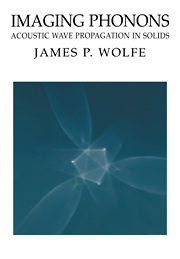Book contents
- Frontmatter
- Contents
- Preface
- Prologue – Anisotropic heat flow in crystals
- 1 Ballistic heat pulses and phonon imaging – A first look
- 2 Phonon focusing
- 3 Generation and detection of phonons – Experimental aspects
- 4 Focusing in cubic crystals
- 5 Acoustic symmetry and piezoelectricity
- 6 Lattice dynamics
- 7 Imaging of dispersive phonons
- 8 Phonon dynamics
- 9 Bulk scattering of phonons – Experiments
- 10 Quasidiffusion and the phonon source
- 11 Phonon scattering at interfaces
- 12 Refraction and reflection at solid/solid interfaces – Experiment
- 13 Imaging ultrasound in solids
- 14 Imaging surface acoustic waves
- 15 Interactions of ballistic phonons with electrons
- Appendix I Algebraic solution to the wave equation
- Appendix II Abbreviated tensor notation and group velocity
- Appendix III Survey of phonon focusing in cubic crystals
- Index
5 - Acoustic symmetry and piezoelectricity
Published online by Cambridge University Press: 24 March 2010
- Frontmatter
- Contents
- Preface
- Prologue – Anisotropic heat flow in crystals
- 1 Ballistic heat pulses and phonon imaging – A first look
- 2 Phonon focusing
- 3 Generation and detection of phonons – Experimental aspects
- 4 Focusing in cubic crystals
- 5 Acoustic symmetry and piezoelectricity
- 6 Lattice dynamics
- 7 Imaging of dispersive phonons
- 8 Phonon dynamics
- 9 Bulk scattering of phonons – Experiments
- 10 Quasidiffusion and the phonon source
- 11 Phonon scattering at interfaces
- 12 Refraction and reflection at solid/solid interfaces – Experiment
- 13 Imaging ultrasound in solids
- 14 Imaging surface acoustic waves
- 15 Interactions of ballistic phonons with electrons
- Appendix I Algebraic solution to the wave equation
- Appendix II Abbreviated tensor notation and group velocity
- Appendix III Survey of phonon focusing in cubic crystals
- Index
Summary
Degeneracy and the slowness surface
All the intricate focusing effects considered in Chapter 4 occur for crystals with very high (cubic) symmetry. One might rightly wonder what added complexity appears for crystals of lower symmetry. That is the subject of this chapter. We shall see that the phonon-focusing patterns of real crystals show many variations and yet have underlying similarities. We are aided by the fact that the acoustic symmetry – i.e., the symmetry displayed by the slowness surface – is generally higher than the point-group symmetry of the crystal. For example, all crystals possess centrosymmetric slowness surfaces (i.e., they are invariant to the inversion k → −k), but not all crystal structures have a point of inversion.
Further good news is that we have already been introduced to all the basic topological features. At lower symmetries, there are still only three slowness sheets, which can contact each other conically, tangentially, or, in rare cases, along a line. Just how these degeneracies are distributed over the slowness surface, however, will vary from one crystal class to the next.
The accompanying bad news is that, with the exception of cubic and hexagonal crystals, it is virtually impossible to study systematically the multidimensional elastic parameter spaces. Figure 1 shows several crystal types and the elastic parameters required to describe each. While cubic crystals have only two independent ratios of elastic parameters (a = C11/C44 and b = C12/C44), hexagonal crystals have four ratios, implying a four-dimensional elastic-parameter space.
- Type
- Chapter
- Information
- Imaging PhononsAcoustic Wave Propagation in Solids, pp. 122 - 145Publisher: Cambridge University PressPrint publication year: 1998



